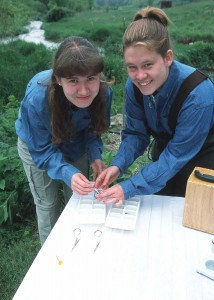Perceiving and Processing Information
Applying the Learning Cycle: Teaching Strategies using Water Examples
Learning Styles
While you probably do not tackle each learning task in exactly the same way, over time you have developed a pattern of behavior that you use for new learning. This is your learning style—your preferred, most comfortable mode of learning. While each of us has a preferred mode, we can also learn in other modes. In fact, people who learn well through different learning styles have an advantage over those who do not. They can select from their repertoire the mode best suited for the task at hand. One of the goals of understanding your learning style is to get to know your preferred pattern of learning behaviors and their appropriate use, and to stretch your abilities in alternative modes.
There are a number of theories that define and describe perceived learning styles. The Wikipedia entry for Learning Styles provides a summary of the major terms along with a brief description of each model. It also includes a summary of several critiques evaluating the impact on the learner of applying learning style theories in learning design. There is a lengthy bibliography. At the least, it is useful to be aware of potential differences between the way one person learns and how another person learns and to adapt the learning environment as possible.
One of the most familiar models, the VARK model, was developed by Neil Fleming (1995). VARK describes 4 primary ways that people learn: V = visual; A = auditory; R = read/write; K = kinesthetic. These are described in greater detail in I’m different; not dumb. Modes of presentation (V.A.R.K.) in the tertiary classroom (PDF), along with implications for its use in learning design.
Bernice McCarthy (2000, 1980) provides one model for how to think about learning styles. Her work is based upon research from learning theorists and brain research.
REFERENCES
Fleming, Neil D. (July 1995). “I’m different; not dumb: modes of presentation (VARK) in the tertiary classroom” (PDF). In Zelmer, A. C. Lynn; Zelmer, Amy Elliott. Higher education: blending tradition and technology: Proceedings of the 1995 Annual Conference of the Higher Education and Research Development Society of Australasia (HERDSA).
McCarthy, B. (2000). About Teaching: 4MAT® in the Classroom. Wauconda, IL: About Learning, Inc.
McCarthy, B. (1980). The 4MAT® System: Teaching to Learning Styles with Right/Left Mode Techniques. Barrington, IL: EXCEL, Inc.
About Learning | Official Site of Bernice McCarthy’s 4MAT System




